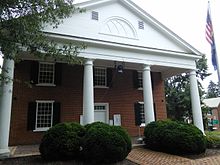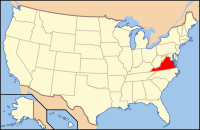Charlotte County, Virginia
| Charlotte County, Virginia | |
|---|---|

Charlotte County Courthouse in September 2014
|
|
 Location in the U.S. state of Virginia |
|
 Virginia's location in the U.S. |
|
| Founded | 1764 |
| Named for | Queen Charlotte |
| Seat | Charlotte Court House |
| Largest town | Keysville |
| Area | |
| • Total | 478 sq mi (1,238 km2) |
| • Land | 475 sq mi (1,230 km2) |
| • Water | 2.2 sq mi (6 km2), 0.5% |
| Population (est.) | |
| • (2015) | 12,201 |
| • Density | 26/sq mi (10/km²) |
| Congressional district | 5th |
| Time zone | Eastern: UTC-5/-4 |
| Website | www |
Charlotte County is a United States county located in the south central part of the Commonwealth of Virginia. Its county seat is the town of Charlotte Court House. As of the 2010 census, the county population was 12,586. Charlotte County is predominately rural with a population density of only 26.5 persons per square mile.
The county was formed in 1764 from Lunenburg County, and it is named for Queen Charlotte, wife of King George III of England. The county residents later became staunch supporters of independence and the American Revolution, and Founding Father Patrick Henry was one of its most famous residents. His grave and the national memorial dedicated to him is located in Charlotte County.
European settlement of the future county began in the early 18th century, and early settlers included mostly English people, with some French Hugenots and Scotch-Irish. After approximately fifty years of European settlement, the House of Burgesses established and incorporated Charlotte County in 1764 from part of Lunenburg County. The new county was named in honor of Charlotte of Mecklenburg-Strelitz, the Queen and wife of King George III of England.
Residents of Charlotte County were heavily involved in the American Revolution. County delegates supported resolutions against the Stamp Act of 1765, and the county government was the second governing body to declare independence from English rule. In addition, Charlotte militia units fought under General Robert Lawson during the Yorktown campaign, which effectively led to the end of the American War of Independence. Finally, the final resting place and national memorial to revolutionary hero Patrick Henry is at Red Hill Plantation.
...
Wikipedia
